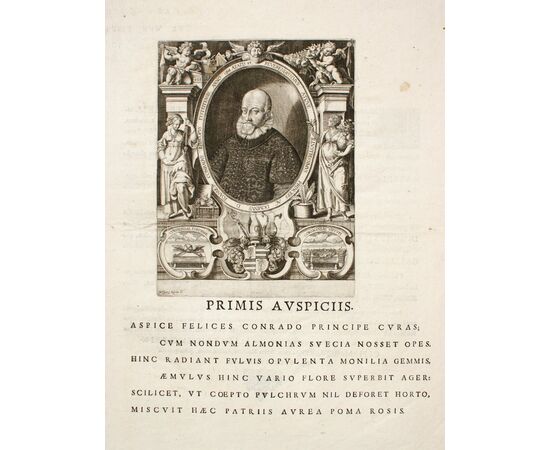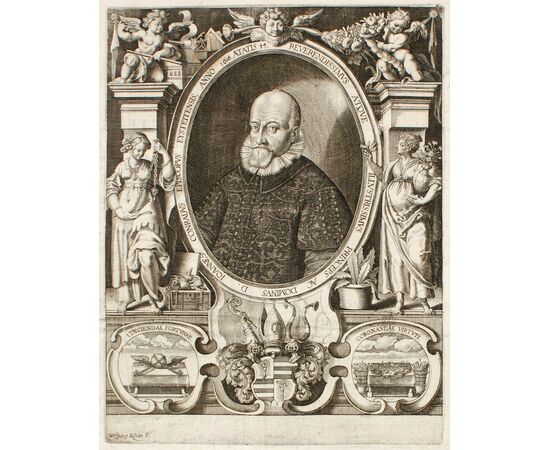Wolfgang KILIAN (Augsbourg 1581 - 1662) ...
Wolfgang KILIAN (Augsbourg 1581 - 1662) by BASILIUS BESLER (1561 - 1629) "HORTUS HEYSTETTENSIS sive diligens et accurate omnium plantarum, florum, stirpium, et variis orbis terrae partibus, singular studio collectarum" Eichstatt 1613 "Johann Konrad von Gemmingen" Original engraving etching signed in the plate on the bottom left "Wolfgang Kilian F", inserted in the sheet .... of the first volume of the work "HORTUS HEYSTETTENSIS sive diligens et accurate omnium plantarum, florum, stirpium, et variis orbis terrae partibus, singular studio collectarum ”printed in Altdorf by Conrad Bauer and published in the first edition in Eichstatt in 1613. Beautiful specimen printed with a magnificent ink rich in shades of gray on laid paper without watermark, full sheet, with few, small foxing spots and others minimal defects such as a slight horizontal central fold but overall in excellent condition. Johann Konrad von Gemmingen was born in Tiefenbronn in 1561 to Dietrich IX von Gemmingen Councilor of the city of Augsburg and to Lia von Schellenberg, he was already entrusted to the care of his uncle Johann Otto von Gemmingen Archbishop of Augsburg who will be his mentor and who will direct to theological studies. Between 1579 and 1589 Johann Konrad attends the best European universities, Friborg, Pont au Mosson, Paris, Siena, Perugia and Bologna among others, learns Latin in depth and also takes possession of the French and Italian that are currently spoken, in close relationships academics with important scholars and prelates and he also opens up to the world of science, discovering himself particularly attracted to botanical studies. On 2 July 1595 Johann Konrad was appointed Bishop of Eichstätt, a small town in Bavaria on the banks of the Altmühl River about eighty five kilometers northwest of Munich where a complex of buildings with residence and fortification functions was already called Willibaldsburg since the eighth century . With the arrival of the new Bishop, this residence was subjected to major renovation and embellishment works, especially with a series of beautiful gardens built around the palace in a dominant position over the city. These gardens were at the same time container and exhibitor of one of his greatest passions, botany. One of the most important encounters in von Gemmingen's life was with a Nuremberg pharmacist and botanical scholar named Basilius Besler. Besler was born in Nuremberg on February 13, 1561 and together with his brother Hieronimus he devoted himself to the study and experimentation of the pharmaceutical and natural sciences in the botanical garden and in the natural enkabinett of their property, until he entered the profession of pharmacist in 1589 in the exercise called "Zum Marienbild ”located in Heumarkt, the current Theresienplatz in Nuremberg. The two brothers had from them the advantage of the excellent relationship they were able to weave with Joachim Camerarius (1534 - 1598), one of the most prestigious physicians, naturalists and botanists of Germany at the time. Camerarius was the one who had advised von Gemmingen in the construction of the beautiful Eichstätt gardens, had followed the formation and choice of plants. At his death the Bishop offered Besler to succeed him in this role and the relationship between the two, fueled by von Gemmingen's narcissistic desire to give life to an indelible testimony of his wealth, the project of one of the most important "Florilegi" of the history of publishing, the magnificent "HORTUS EYSTETTENSIS". Bibliography: Littger "Der Garten von Eichstatt" Cologne 1999. Milesi "Dictionary of Engravers" Bergamo 1989 pag.197. Nissen "Die Botanische Buchillustration" Stuttgart 1966. Pritzel "Thesaurus Literaturae Botanicae" Leipzig 1871-77. Measurements in mm: 256 x 198 on sheet 535 x 418




